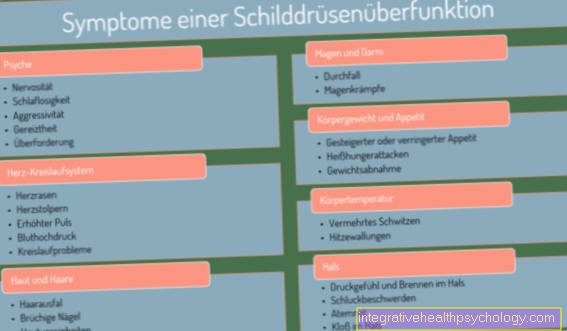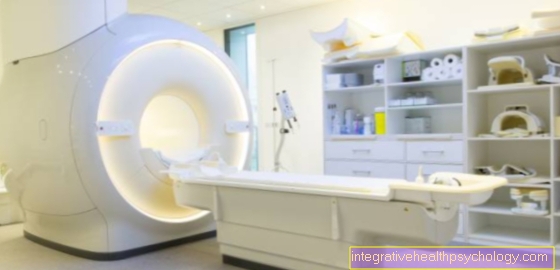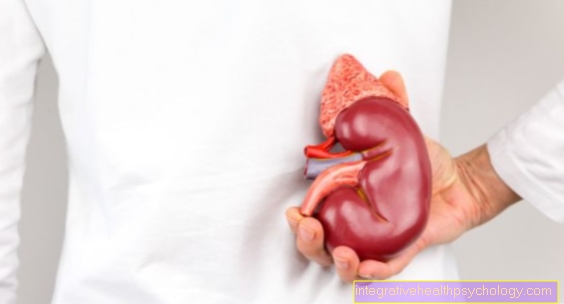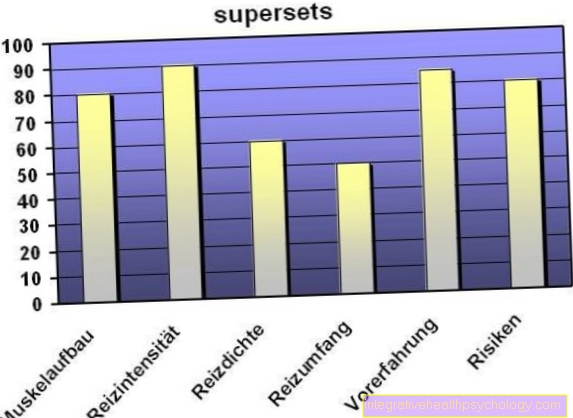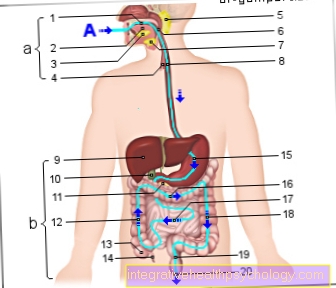water in the lungs
definition
Water in the lungs describes pulmonary edema, in which there is massive leakage of fluid from the pulmonary capillaries into the alveolar space of the lungs.

causes
This article explains some of the following causes of water in the lungs:
- cardiac cause
- non-cardiac causes
- lung infection
- surgery
- cancer
- Metastases
Cardiac cause
Water in the lungs (Pulmonary edema) can arise from various causes.
Most often the underlying cause is heart failure (Heart failure), which mainly affects the left ventricle (the left heart muscle) concerns.
If the heart is weakened, it can no longer pump the blood properly into the circulation. This causes the blood to build up from the left ventricle via the left atrium and back into the pulmonary circulation.
This back pressure increases the pressure in the pulmonary vessels. This has the consequence that liquid from the capillaries (smallest pulmonary vessels) into the tissue between the lungs (Interstitium) and the alveoli (Alveoli) is pressed and collects here as water.
This is called cardiac pulmonary edema, as the heart is responsible for the accumulation of water in the lungs.
Read more on the topic: Heart failure
Non-cardiac causes
The second most common cause of water in the lungs is kidney failure (Renal failure).
When the kidneys stop working properly, the body no longer excretes enough fluids. This leads to a general overhydration of the body.
In this case, the blood is much thinner; it contains more liquid than solid components such as protein. In order to compensate for this imbalance, fluid flows from the blood into the tissue. This can lead to water retention in the legs (Leg edema, "thick legs"), but also water retention in the abdomen (Ascites) or in the lungs (Pulmonary edema).
Such cases, in which the water in the lungs has no cause affecting the heart, are called noncardiac pulmonary edema.
Non-cardiac pulmonary edema can also result from diseases of the lungs or from allergic reactions. In most cases, the permeability of the pulmonary vessels, i.e. the permeability of the pulmonary vessels, is increased and more fluid can escape into the spaces between the lungs and alveoli.
Read a lot more information on this topic: Causes of water in the lungs
lung infection
Pneumonia can often be caused by water in the lungs, which can be seen on a chest x-ray Pulmonary infiltrate shows. Pneumonia causes fluid to accumulate and inflammatory cells to migrate (Leukocytes) from the pulmonary vessels into the inflamed lung tissue. The inflammation is usually the result of an infection with a bacterial pathogen, the so-called most common among young people Pneumococci (Globular bacteria of the genus Streptococci, Syn. Streptococcus pneumoniae) the trigger.
Pneumonia manifests itself as a sudden, severe feeling of illness with a high fever, a productive cough with purulent sputum (yellowish-green) and an increased respiratory rate, difficult breathing, which may also be accompanied by pain if the inflammation also affects the lung membrane has spread.
However, in the case of infection with other pathogens and especially in elderly patients, different symptoms can occur. With this so-called atypical pneumonia (Pneumonia) there is a rather insidious onset with a slight fever, headache and body aches, a dry cough and shortness of breath.
Read more about the topic here: Signs of pneumonia
surgery
Temporary water retention in the lungs can occur, especially after major surgery.
This can have several causes. Quite often, and especially after lying down for a long time during the operation, this can be an indication of a reduced adjustment and is completely harmless. Most of the time, there is only a small amount of fluid in the lungs that the patient does not notice.
During an operation, patients are mostly ventilated, i.e. they do not breathe themselves and have a tube pushed into their windpipe. Despite the safety precautions, it can happen that the patient chokes unnoticed during the operation.
This can lead to pneumonia, a so-called Aspiration pneumonia, arise, which then leads to increasing water retention in the lungs. Here the patient's complaints are usually stronger than with the simple and uncomplicated changeover during the waking up phase.
There are also severe courses in which large amounts of water can accumulate in the lungs. A collapse of the organ system and multiple organ failure can cause the lungs to flood with water.
Multi-organ failure occurs almost exclusively after long and difficult operations and mostly only when the patient is pre-stressed and has many comorbidities. Elderly patients, e.g. whose kidneys are previously damaged, which also have severe heart failure (Heart failure) and have diabetes mellitus and e.g. who have to undergo heart surgery are at high risk of getting water in their lungs during and after a long procedure.
The reason is usually that in the case of multiple organ failure, the kidneys are no longer able to move the water out of the body.
This water is then deposited in the drooping parts of the body and also in the lungs. If the amount of water in the lungs increases significantly, the patient feels short of breath. Prompt treatment must be started. This cause is rare and requires urgent intensive care treatment.
Pneumonia occurs much more frequently after severe surgical interventions, which, if severe, can also lead to water entering the lungs. In addition to shortness of breath, it can also cause a cough.
For this reason, after lengthy surgical interventions, especially of the heart, an x-ray of the lungs is usually made in order to detect and treat pneumonia and water in the lungs at an early stage.
cancer
With any cancer, water can form in the lungs as the cancer progresses and spreads. However, in this case one should differentiate where the water collects in the lungs. The term "water in the lungs" is typically used to describe pulmonary edema. This is a clinical picture in which, as a result of changed pressure conditions in the cardiopulmonary circulation, fluid enters the alveoli.
However, the water can also collect in the gap between the lungs and the lung membrane, a so-called pleural effusion. This is much more common with cancers, especially lung cancers. In the course of cancer of the lungs, an inflammatory reaction occurs around the cancer, which washes in liquid to break down the inflammatory foreign body. With larger amounts of this liquid, as part of the inflammatory reaction, it can spread through the lungs or the cleft lungs and cause severe shortness of breath. Additional ingrown lymphatic vessels, which normally transport harmful substances away, can also be compressed by the cancer, whereby additional lymph fluid collects in the lungs and also leads to symptoms.
Another cause of water build-up in the lungs may be the cancer's mechanical obstruction to lung movement. A large, well-advanced cancer is preventing the lungs from expanding at their normal rate. As a result, water can collect in areas that are no longer sufficiently developed and lead to pulmonary edema with severe shortness of breath.
Click here for the article: Lung cancer
Metastases
Metastases are a common and dreaded complication of almost every cancer. Here, the lungs are one of the organs into which a large number of tumors spread. These lung metastases then behave in a similar way to lung cancer and can lead to serious complaints in the lungs.
As with cancer in the lungs, the presence of metastases leads to an inflammatory reaction in the surrounding tissue. This in turn leads to the influx of fluid and the ingrowth of new lymph vessels. If the ratio of water inflow to water outflow is not balanced, pulmonary edema develops and water forms in the lungs.
Symptoms
Depending on the stage, there are different manifestations of the symptoms. At first only in the lung tissue (Interstitium) Fluid that later enters the alveoli (Alveoli) and even crosses the bronchi. The more pronounced these stages are, the stronger the symptoms are usually.
If the liquid is still limited to the pure lung tissue (Interstitium) there is faster breathing or increased breathing rate (Tachypnea), an aggravated breathing noise and possibly an auscultable secondary breathing noise during exhalation (Wheezing), which is described as a dry and whistling sound. A “seething” breath sound can also occur. This is caused by the air flow in the fluid in the alveoli and can be heard with a stethoscope while listening.
You may also experience shortness of breath or shortness of breath as part of pulmonary edema (Dyspnea) come. This means that the patient has difficulty breathing and cannot take in enough oxygen.
This shortness of breath can be so pronounced that the affected patient has to use the auxiliary respiratory muscles. Here, the patient is best able to breathe in an upright sitting position with active support for breathing (Orthopnea).
Another symptom is a cough. This is caused by the irritation of fluid in the alveoli and bronchi. A frothy and bloody sputum may also come out.
The last symptoms can be summarized as so-called asthma cardiale. This so-called asthma cardiale includes shortness of breath, especially when lying down, and the associated symptoms such as cough and shortness of breath. These are improved by sitting positions which, for example, induce patients to sleep in a semi-sitting position to get an improvement in symptoms.
Overall, the shortage of breath can increase so that the subjective feeling of suffocation occurs. The shortness of breath can also lead to a lack of oxygen, which results in paleness and cyanosis (The lips and fingertips are blue) expresses.
Also read: These symptoms can help you identify water in your lungs
Difficulty breathing with water in the lungs
If there is fluid in the lungs or in the pleural space on the side of the lungs, the lungs can no longer unfold as usual with each breath, on the other hand, it comes to a Reduction of the exchange area for oxygen.
As a result, with each breath, the usual amount of oxygen can no longer pass through the lungs into the blood.
If the restrictions are only minor, the person concerned will notice it not at first or just to greater effort. If there is an increased accumulation of water in the lungs or a greater narrowing of the lungs by one Pleural effusionthe person concerned feels already with less effort Shortness of breath.
As the lungs contract, it also occurs Difficulty breathing at rest. As soon as the patient complains of shortness of breath, the cause should be found out and appropriate treatment should be carried out. The first step is that Cause of water in the lungs to fix.
Then follows the Drug flushing of the water from the lungs. This is done using water tablets or an infusion that can be applied for a short time.
After infusion, the drug can also be given as a tablet for a few days or weeks. A X-ray of the lungs be performed. If there is water in the lungs, this is noticeable in the form of a light shade in the X-ray image.
Cough with water in the lungs
If water enters the lungs or the left or right pleural clefts, on the one hand there is a reduced gas exchange, which can lead to the onset of shortness of breath.
However, the lungs are also stimulated at the same time, which means that the patients either complain of a dry or productive and wet cough.
If there is a lot of water in the lungs, there is usually a combination of shortness of breath and coughing.
There are several other diseases in which this combination is present (e.g. pulmonary embolism or pneumonia).
For this reason, an exact diagnosis must first be made of the origin of the shortness of breath and the cough before the treatment is carried out.
Usually an X-ray provides information about the cause. It can be carried out quickly and is the diagnostic tool of choice.
Consequences of water in the lungs
The course of pneumonia can vary depending on age, immune defense status, type of pathogen and the therapy used. For example, young and previously healthy people are expected to heal, usually without consequences, after about four to six weeks. However, the elderly and people with health problems have the possibility of a longer course of illness or a slower recovery.
Bronchiectasis (enlargement of the alveoli) and pulmonary fibrosis (scarring of the lung tissue) can occur, especially if the course is chronic. There are also other complications in the context of pneumonia. For example, in Pleural space, the space between the pleura covering the lungs and the pleura, pus (so-called. Pleural empyema) or liquid (so-called. Pleural effusion) accumulate. If this results in a severe restriction of breathing, a doctor can remove fluid through a puncture and thus lead to an improvement in the breathing difficulties.
In the worst case, pneumonia could also spread in the bloodstream and develop into so-called sepsis (blood poisoning). Here, the pathogen can other organs such. B. affect the heart or kidneys, which can lead to their loss of function and ultimately fatal.
As a result of water retention in the lungs due to cardiac or kidney weakness, severe shortness of breath can occur with the development of pulmonary edema, as well as a blue discoloration of the mucous membranes, the nose and the tips of the fingers and toes, as the lungs, in the case of very severe disease Can no longer adequately supply tissue with oxygen.
Pleural empyema is also a result of water in the lungs and describes an accumulation of pus in the lungs. It is therefore advisable to deal with this topic as well: Pleural Empyema - What's Behind It?
diagnosis
In order to make the diagnosis of water in the lungs or pulmonary edema, you must first take a sufficient anamnesis, i.e. talk to the patient to record the symptoms and find possible causes.
A clinical examination is then necessary. In this, the general picture of the patient is assessed to see whether there are external signs such as paleness or bluish discolored lips or fingers (Signs of cyanosis, i.e. a lack of oxygen) gives.
The examiner also pays attention to the patient's breathing, whether he is breathing intensely, whether the auxiliary respiratory muscles are deploying (For example, sitting upright with your arms supported), coughs or breathing sounds and faster breathing can be heard without a stethoscope.
This is followed by percussion and auscultation, during which the lungs are examined more closely. During auscultation, particular attention is paid to the so-called wheezing, a wet rattling noise, which occurs as a background noise in addition to the normal breathing noise and can be heard primarily in the lower sections of the lungs.
Also knocking (percussion) of the lungs often already indicates water in the lungs.
An x-ray is often taken to confirm the diagnosis. On this, the examiner can determine typical changes depending on the severity and extent of the pulmonary edema.
If underlying heart diseases are to be examined, an EKG (electrocardiogram) or a cardiac ultrasound (Echocardiography) be performed.
To determine the severity of the shortness of breath, a blood gas analysis with blood from the earlobe or wrist can be performed. The oxygen and carbon dioxide levels in the blood are measured.
Of course, it should be noted that in an emergency, i.e. when the pulmonary edema is very acute, the diagnosis must be made more quickly in order to initiate the correct measures more quickly.
Longer examinations such as a detailed and long anamnesis may then be omitted.
Read more on the topic: Chest x-ray (chest x-ray)
therapy
In therapy, a distinction is made between immediate measures, which should lead to rapid relief of symptoms and complaints, and causal therapy, which is intended to remedy the original problem, which is why there was water in the lungs.
In any case, it is important to be admitted to a hospital, as medical assistance must be guaranteed in all cases.
The immediate measures include a sitting position of the patient in which the legs should be kept low (hanging legs). This lowers the hydrostatic pressure in the vessels, especially the pulmonary arteries, which is intended to reduce the transfer of fluid into the tissue. It is also important to calm the patient down and possibly remove tight clothing and other measures that make breathing easier.
Sedatives such as morphine or diazepam can be administered to relieve the patient of pain and calm him down. However, this must not be taken if respiratory depression (too slow and inadequate breathing) is present.
In addition, the patient is supplied with oxygen via a nasogastric tube. At the same time, the secretion and the liquid should be sucked off through a tube in order to improve the situation acutely and to make breathing easier.
In severe cases, the patient may have to be temporarily ventilated.
The choice of causal therapy depends on the cause of the disease.
Was the water in the lungs caused by a cardiac cause, i.e. a weak heart (Heart failure), drugs must be given that reduce the load on the heart. These include, for example, nitroglycerin or diuretics, for example furosemide. The latter promote the excretion of water by the kidneys, which reduces the volume in the bloodstream and relieves the heart.
If the kidneys are weak and the blood volume and stress are too high, dialysis ("Blood washing") is displayed.
When the trigger is toxins or an allergy, corticosteroids are often given.
Water in my lungs despite dialysis
Dialysis is an invasive procedure which is mainly used in patients with renal insufficiency in order to “wash” the entire blood volume once.
The dialysis machines can also be programmed to remove water from the body in order to relieve edema in different parts of the body. However, since only the total volume of fluid is reduced during dialysis therapy and water is not withdrawn from a specific point, edema may not regress sufficiently despite dialysis.
If this is the case, you should wait several dialysis sessions and give the body time to redistribute the volume of fluid. In addition, drug therapy for dehydration should be considered and a drinking quantity restriction should be set up. If the water is only in the gap in the lungs, a puncture can be made to relieve the pressure.
Puncture of the lungs (pleural puncture)
If water has entered the lungs or the pleural space, there are a number of ways to get it out.
On the one hand, the triggering cause that led to water in the lungs must be switched off.
On the other hand, an attempt can be made to increase urine production with flushing drugs (diuretics).
As a result, more water is transported out of the body at the same time. If this treatment is carried out for a few days, the water in the lungs will slowly decrease.
The medication to be washed out can be given to the patient by infusion (especially when there is a large amount of water in the lungs) or by tablets (especially when there is a small amount of water).
If these measures are not sufficient and water continues to enter the lungs or the pleural space, further and above all invasive measures must be taken to prevent the increasing overhydration of the lungs.
If fluid collects in the pleural space, a small needle can be used to access the pleural space.
The liquid then runs out of the gap and can be collected. One also speaks of the so-called Pleural puncture.
Before doing this, the area that will be punctured is disinfected and the surrounding area is covered in a sterile manner.
The pleural effusion is detected using an ultrasound device and the access is then placed at this point. This remains there until enough liquid has drained off. If there is no more fluid in the pleural space, the patient usually begins to cough. The success is confirmed by an X-ray.
If not enough water has drained off, it may be necessary to repeat this puncture.
You can find a lot more information under our topic: Pleural puncture
forecast
If treatment is initiated quickly and efficiently when there is water in the lungs, the prognosis is very good.
In rare cases, pneumonia (pneumonia) arise on the basis of pulmonary edema.
It is important that the prognosis always depends on the type and extent of the underlying disease causing it.
How dangerous can that be in the worst case?
Water in the lungs or in the gap between the lungs hinders breathing and the exchange of oxygen. Depending on the extent and quantity of the water, it can lead to severe shortness of breath and a lack of oxygen. If the water in the lungs develops slowly and the symptoms gradually increase, the lungs can also tolerate and adapt to large amounts of water. Here a slow therapy is enough to drain the water.
However, if large amounts of water rapidly flow into the lungs or the gap in the lungs, the lungs do not have sufficient reserve and compensation mechanisms, which leads to severe shortness of breath. This may need to be treated in an intensive care unit and may require invasive ventilation.
Life expectancy
If pneumonia is the cause of the water in the lungs, this with the typical symptoms should definitely be recognized and treated early, as it is a serious illness. After all, it is still the infectious disease that most frequently leads to death in industrialized nations.
Elderly patients, infants, small children and immunocompromised people in particular have Pre-existing illnesses an increased risk. Therefore, patients from the age of 65, with unstable cardiovascular systems or those with impaired consciousness should definitely be treated as inpatients in a clinic. In addition to drug therapy with an antibiotic, the general condition can be monitored and appropriate measures can be initiated quickly if it deteriorates. In the case of milder symptoms of pneumonia, outpatient treatment can also be provided, whereby a check-up should be carried out no later than 2-3 days afterwards.
If water is retained in the lungs as part of another underlying disease such as heart failure or kidney weakness, the course of the disease essentially depends on how severe the disease has already progressed and how it is treated. Often no cure is possible, but the symptoms can often be alleviated to such an extent that the patient can lead an almost unrestricted life. This assumes that the person concerned, in addition to drug therapy, pays attention to his lifestyle.
More on this: Life expectancy with water in the lungs


